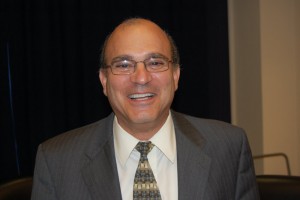
A property owner’s three-year stand-off with Flagler County that has delayed a long-promised beach renourishment in Flagler Beach is over. Cynthia d’Angiolini through her lawyer today agreed to sign a pair of easements, clearing the way for the U.S. Army Corps of Engineers’ dune-rebuilding project–and ensuring that the south side of the city will finally get a major new protective buffer against rising seas.
“We have a deal,” Scott Spradley, who represents the county in the case, said this evening, hours after a hearing before federal Bankruptcy Judge Lori Vaughan this afternoon in Orlando.
It is a momentous development for Flagler County and Flagler Beach, not only ending an often bitter struggle with an ever-decreasing number of holdouts, but that will also restore a sense of security for property owners along that long stretch of shore, once the dunes are rebuilt, while recreating a wider, more durable beach: the U.S. Army Corps of Engineers’ project has a 50-year lifespan. As a federalized beach, that stretch will always be renourished during that time span in the aftermath of ruinous storms, at the federal government’s expense.

“There’s certain features to the agreement that will come out when Mr. Hadeed makes his presentation to the county on Monday,” Spradley said, referring to County Attorney Al Hadeed, who’s piloted the easement odyssey for the past three years. “But at the end of the day, the two primary terms are that the county will get its easements and that no money will change hands.”
The easements affect so-called “dune remnants,” small, thin parcels of land on the east side of State Road A1A. The remnants will be used by the U.S. Corps of Engineers to rebuild a dune system that has been severely eroded over the years, along 2.6 miles of beach south of the Flagler Beach pier. Some 140 property owners signed the easements over the past three years. They did not give away their land. They are only giving the U.S. Army Corps of Engineers permission periodically to work on the land, to rebuild dunes and renourish them from time to time.

It worked.
“The county commission should be thanked for allowing us to take these novel approaches, to do whatever it takes for the good of the county,” Spradley said, “and by that I mean intervene in this bankruptcy case. That was a big move by the county to allow that to happen.” But for that, there likely would not have been a deal–especially not one where no money changed hands.
The U.S. Army Cors of Engineers had been ready to move ahead with the renourishment project since 2018, awaiting the easements. The $17 million for the project was secured, with a mix of federal and state dollars. The necessary sands were secured: they’re in a borrow pit 11 miles offshore. But because of the delays over the easements and a succession of storms, the shore was carved out significantly more since 2018, requiring the Corps to announce ion late December that it would need to recalibrate the project and more than triple the sand necessary for it. The project is not expected to get under way until either the end of this year or the beginning of next year.
More to the point: it would not have gotten under way, and the county was at risk of losing the majority of the money secured for it, had the easements not been secured.
Today’s hearing was not expected to result in a resolution–and indeed, the hearing itself is not what resolved it. Rather, d’Angiolini’s attorney, Jeffrey Ainsworth of Orlando, Spradley and Hadeed (who was also in Orlando today) were in intense negotiations, which continued during a recess and led to the settlement agreement. (Hadeed could not be reached before this article initially published.)
“After after the hearing got underway and both sides made some opening statements, I made statements for the county and Jeff Ainsworth made statements for Ms. d’Angiolini,” Spradley said, “We asked the court for a brief recess so we could continue our discussions that began before the hearing. And so in a matter of 15-20 minutes, we resolve the matter by agreement, and then came back in and announced it to the court.” D’Angiolini was not in Orlando, but Ainsworth was in contact with her throughout. Spradley said his inclination was that the court would approve it.
Vaughan, the judge, gave the two sides, d’Angiolini’s especially, further incentive to ensure that the settlement sticks. If it does not, the judge set a trial date on April 17. “That’ll give the parties ample time to get it documented and approved,” Spradley said.
By this evening, Spradley was back in Flagler Beach, attending a highly anticipated public meeting at the Wickline Center: the city’s contracted designers were unveiling the first plans for a new pier, a meeting that won over a large crowd both because of the enthusiasm of the designers and the clarity of the design principles. (See: “Flagler Beach’s New Concrete Pier Will Be 10 Feet Higher to Account for Sea Rise and Violent Storms.”)
For Spradley, who’s also a photographer and who begins every morning by going to the shore and taking a picture of that day’s sunrise, the coast and the pier have personal resonance (a photograph of the pier he gifted the city commission hangs in the commission’s meeting room). So today’s twin developments seemed like a particular triumph for the city and, to no small degree, for Spradley (and Hadeed).
“It was a great day. You know, it was an awesome day,” Spradley said. “If this settlement does what I believe that it will, which is get approved by the county and get approved by the bankruptcy court, then I will look back on this day as just a monumental day in my legal career for sure. But also for the for the community. Here we have in one day, in a span of three hours, we have this dune easement issue resolved, and we have what I thought was a fabulous presentation about our new pier. On the same afternoon. So it’s a red-letter day.”
![]()





























Simon says
About damn time! Glad the legal pressure worked because this woman obviously didn’t care about everyone else in the county.
The dude says
More federal dollars raining down on this “resilient” state… again.
Erod says
Question, what will they do when the next hurricane wipes out the dunes ? I know spend millions more on studies, sand and reconstruction and wait for the next hurricane.
Who would have thought there would be millions of dollars in sand ?
LDRM says
What would you recommend?
Robin says
Finally!
DoubleGator says
Should have used Eminent Domain a long time ago!
Mothersworry says
I agree! The county/ city gave more than ample time to her. Now we are unprotected, it will cost a bunch more for something that could have been resolved years ago.
The ORIGINAL land of no turn signals says
Good old Cynthia should reimburse the county for legal fees.
DMFinFlorida says
@ The ORIGINAL
My immediate thought as well. Look at all the time wasted, taxpayer dollars, and headaches for all the surrounding neighbors who tried to cooperate for the good of the shoreline. How selfish.
Mothersworry says
I agree! The county/ city gave more than ample time to her. Now we are unprotected, it will cost a bunch more for something that could have been resolved years ago.
John r clayton says
So, why instead of constantly paying for more sand and more work…
Is Flagler Beach not investing in a storm jetties system a hundred yards or so off the beach?
Broken walls of rubble rock to build a wave break that reduces much of the erosion problem?
It also creates massive animal habitat, fishing opportunities, etc…
The definition of insanity is to do the same thing over and over expecting a different result…
Just sayin
larry alan lefstead says
Spardley and Hadeed should be both recognized and congratulated for their tanaous ability in getting this accomplished.
It is rare these days to see officials go the distance, especially the unique way that this was orchestrated to obtain the best results.
Great work to all involved!